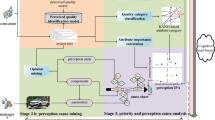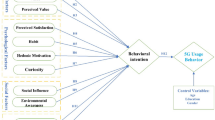Abstract
Perceived quality reflects consumers’ subjective perceptions of a product and is important for manufacturers to improve quality. In recent years, social media becomes a new channel for consumers to share perceived quality, but existing studies overlooked the information usefulness of each piece of data, which creates barriers for manufacturers to process impactful information. This paper proposes a two-stage approach to quantifying perceived quality based on information usefulness. First, the usefulness categories of perceived quality are identified through a combination of deep learning and the knowledge adoption model; then, multiple usefulness categories are considered to quantify the perceived quality information. In the empirical study, the method was validated using an automobile dataset from Autohome. Results show that the method obtains more effective perceived quality information. The proposed method contributes to the research on both perceived quality quantification and information usefulness.
Access this chapter
Tax calculation will be finalised at checkout
Purchases are for personal use only
Similar content being viewed by others
References
Paul, J.: Toward a ‘masstige’ theory and strategy for marketing. Eur. J. Int. Manag. 12(5–6), 722–745 (2018)
Golder, P.N., Mitra, D., Moorman, C.: What is quality? An integrative framework of processes and states. J. Mark. 76(4), 1–23 (2012)
Harju, C.: The perceived quality of wooden building materials—a systematic literature review and future research agenda. Int. J. Consum. Stud. 46(1), 29–55 (2022)
Akdeniz, M.B., Calantone, R.J.: A longitudinal examination of the impact of quality perception gap on brand performance in the US Automotive Industry. Mark. Lett. 28(1), 43–57 (2017)
Chowdhury, H.K., Ahmed, J.U.: An examination of the effects of partitioned country of origin on consumer product quality perceptions. Int. J. Consum. Stud. 33(4), 496–502 (2009)
Yieh, K., Chiao, Y., Chiu, Y.: Understanding the antecedents to customer loyalty by applying structural equation modeling. Total Qual. Manag. Bus. Excell. 18(3), 267–284 (2007)
Yu, C.J., Wu, L., Chiao, Y., Tai, H.: Perceived quality, customer satisfaction, and customer loyalty: the case of lexus in Taiwan. Total Qual. Manag. Bus. Excell. 16(6), 707–719 (2007)
Duraiswamy, V., Campean, F., Harris, S., Munive-Hernandez, J.E.: Development of a methodology for robust evaluation of perceived quality of vehicle body panel gaps. In: The Proceedings of the DESIGN 2018 15th International Design Conference, (2018)
Hazen, B.T., Boone, C.A., Wang, Y., Khor, K.S.: Perceived quality of remanufactured products: construct and measure development. J. Clean. Prod. 142, 716–726 (2017)
Sun, B., Mao, H., Yin, C.: How to identify product defects and segment consumer groups on an online auto forum. Int. J. Consum. Stud. 46(6), 2270–2287 (2022)
Danner, H., Thøgersen, J.: Does online chatter matter for consumer behaviour? A priming experiment on organic food. Int. J. Consum. Stud. 46(3), 850–869 (2021)
He, L., Zhang, N., Yin, L.: The evaluation for perceived quality of products based on text mining and fuzzy comprehensive evaluation. Electron. Commer. Res. 18(2), 277–289 (2018)
Bawden, D., Robinson, L.: The dark side of information: overload, anxiety and other paradoxes and pathologies. J. Inf. Sci. 35(2), 180–191 (2009)
Stylidis, K., Wickman, C., Söderberg, R.: Perceived quality of products: a framework and attributes ranking method. J. Eng. Des. 31(1), 37–67 (2020)
Sussman, S.W., Siegal, W.S.: Informational influence in organizations: an integrated approach to knowledge adoption. Inf. Syst. Res. 14(1), 47–65 (2003)
Wu, R., Wu, H.H., Wang, C.L.: Why is a picture ‘worth a thousand words’? Pictures as information in perceived helpfulness of online reviews. Int. J. Consum. Stud. 45(3), 364–378 (2020)
Filieri, R.: What makes online reviews helpful? A diagnosticity-adoption framework to explain informational and normative influences in e-WOM. J. Bus. Res. 68(6), 1261–1270 (2015)
Liu, X., Wang, G.A., Fan, W., Zhang, Z.: Finding useful solutions in online knowledge communities: a theory-driven design and multilevel analysis. Inf. Syst. Res. 31(3), 731–752 (2020)
Cao, Q., Duan, W., Gan, Q.: Exploring determinants of voting for the ‘helpfulness’ of online user reviews: a text mining approach. Decis. Support Syst. 50(2), 511–521 (2011)
Liu, Z., Park, S.: What makes a useful online review? Implication for travel product websites. Tour. Manage. 47, 140–151 (2015)
Schindler, R.M., Bickart, B.: Perceived helpfulness of online consumer reviews: the role of message content and style. J. Consum. Behav. 11(3), 234–243 (2012)
Chen, Y., Zhang, Z.: Research on text sentiment analysis based on CNNs and SVM. In: 2018 13th IEEE Conference on Industrial Electronics and Applications (ICIEA), pp. 2731–273 (2018)
Zeithaml, V.A.: Consumer perceptions of price, quality, and value: a means-end model and synthesis of evidence. J. Mark. 52(3), 2–22 (1988)
Mitra, D., Golder, P.N.: How does objective quality affect perceived quality? Short-term effects, long-term effects, and asymmetries. Mark. Sci. 25(3), 230–247 (2006)
Yoon, B., Jeong, Y., Lee, K., Lee, S.: A systematic approach to prioritizing R&D projects based on customer-perceived value using opinion mining. Technovation 98, 102164 (2020)
Gottlieb, U.R., Brown, M.R., Drennan, J.: The influence of service quality and trade show effectiveness on post-show purchase intention. Eur. J. Mark. 45(11/12), 1642–1659 (2011)
Singh, A., Jenamani, M., Thakkar, J.J., Rana, N.P.: Propagation of online consumer perceived negativity: quantifying the effect of supply chain underperformance on passenger car sales. J. Bus. Res. 132, 102–114 (2021)
Wang, Y.-Y., Guo, C., Susarla, A., Sambamurthy, V.: Online to offline: the impact of social media on offline sales in the automobile industry. Inf. Syst. Res. 32(2), 582–604 (2021)
Slotegraaf, R.J., Inman, J.J.: Longitudinal shifts in the drivers of satisfaction with product quality: the role of attribute resolvability. J. Mark. Res. 41(3), 269–280 (2004)
Stylidis, K., Wickman, C., Söderberg, R.: Defining perceived quality in the automotive industry: an engineering approach. Procedia CIRP 36, 165–170 (2015)
Stylidis, K., Dagman, A., Almius, H., Gong, L., Söderberg, R.: Perceived quality evaluation with the use of extended reality. In: Proceedings of the Design Society: International Conference on Engineering Design, vol. 1, no. 1, pp. 1993–2002 (2019)
Ma, M.-Y., Chen, C.-W., Chang, Y.-M.: Using Kano model to differentiate between future vehicle-driving services. Int. Ind. Ergon. 69, 142–152 (2019)
Sweller, J.: Cognitive load during problem solving effects on learning. Cogn. Sci. 12(2), 257–285 (1988)
Moradi, M., Zihagh, F.: A meta-analysis of the elaboration likelihood model in the electronic word of mouth literature. Int. J. Consum. Stud. 46(5), 1900–1918 (2022)
Oh, Y.K., Yi, J.: Asymmetric effect of feature level sentiment on product rating: an application of bigram natural language processing (NLP) analysis. Internet Res. 32(3), 1023–1040 (2022)
Author information
Authors and Affiliations
Corresponding author
Editor information
Editors and Affiliations
Rights and permissions
Copyright information
© 2023 The Author(s), under exclusive license to Springer Nature Singapore Pte Ltd.
About this paper
Cite this paper
Yang, T., Dang, Y., Wu, J. (2023). How to Quantify Perceived Quality from Consumer Big Data: An Information Usefulness Perspective. In: Chen, J., Huynh, VN., Tang, X., Wu, J. (eds) Knowledge and Systems Sciences. KSS 2023. Communications in Computer and Information Science, vol 1927. Springer, Singapore. https://doi.org/10.1007/978-981-99-8318-6_5
Download citation
DOI: https://doi.org/10.1007/978-981-99-8318-6_5
Published:
Publisher Name: Springer, Singapore
Print ISBN: 978-981-99-8317-9
Online ISBN: 978-981-99-8318-6
eBook Packages: Computer ScienceComputer Science (R0)




